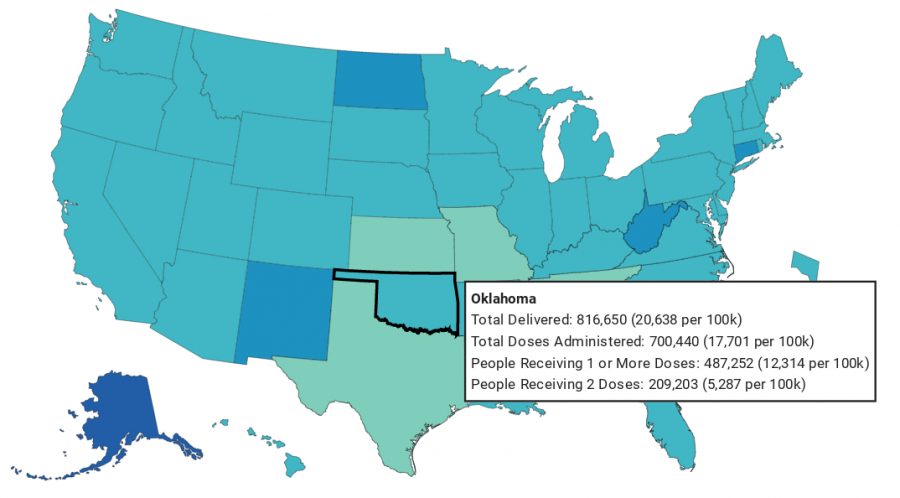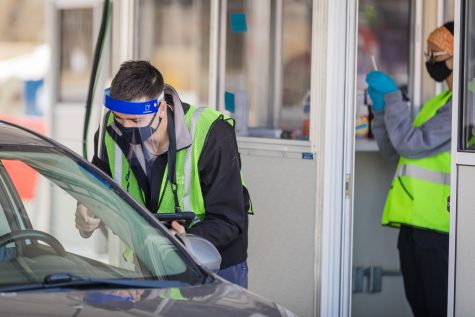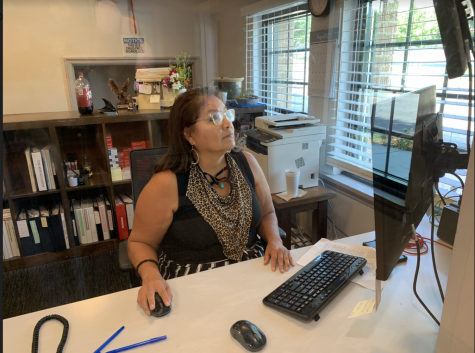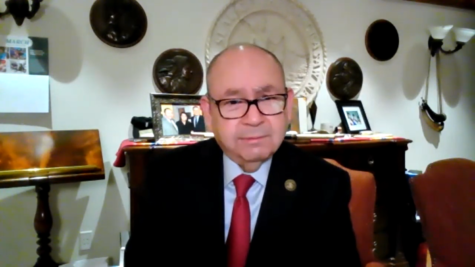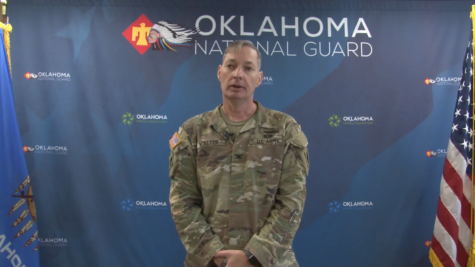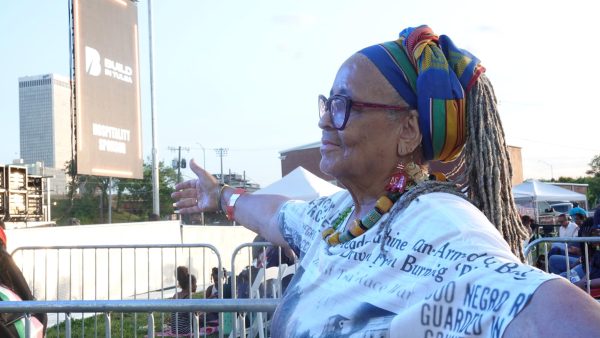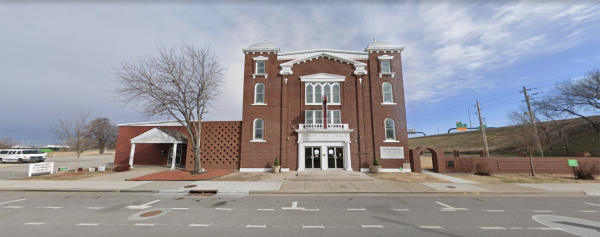Oklahoma vaccinations pushing forward despite record winter storm
The CDC vaccine tracker showing Oklahoma’s vaccine distributions as of Feb. 15. Graphic by Jessie Christopher Smith, Gaylord News
Oklahoma is pushing ahead with its COVID-19 vaccination drive despite severe winter storms that left thousands of people stranded in their homes and some without electricity and running water.
And the state continues to lead most surrounding states in getting the first dose into residents’ arms, in spite of early opposition to the vaccine.
Despite single-digit temperatures, sub-zero wind chills and massive winter storm precipitation that plunged all Oklahoma counties into a state of emergency, state officials said they are prepared for the challenges that may arise in vaccine distribution efforts.
Shipment of six million doses have been delayed nationwide by the storms that swept out of Texas the Heartland into the East Coast.
“I really am not worried about our ability to catch up with that within the next week, two weeks at most probably,” said Oklahoma Department of Health Deputy Commissioner Keith Reed.
While acknowledging that the weather interfered with the vaccination timeline in the past week, Reed said he feels “we’ll be able to make up for lost time pretty easily.”
The intense winter storms and power outages have slowed administering of vaccines at more than 2,000 sites nationwide, and more than one-third of states are experiencing shipment delays.
Some people are worried about the effectiveness of the vaccine if their second-dose appointments get pushed back because of the weather.
Reed said that according to the Centers for Disease Control, there is no evidence of a decrease in the vaccine’s effectiveness as long as the second dose is within 42 days of the first. There is no data on its effectiveness after 42 days, but if a second-dose appointment gets pushed beyond that, the CDC recommends getting the next dose as soon as possible, and not repeating the first dose.
Since the first coronavirus vaccination in the state in December, thousands of Oklahomans have received the completed series of vaccine doses. As of Feb. 18, 22.7% of Oklahoma adults had been vaccinated with at least the first dose. Reed said the state is expecting to receive 110,000 doses any time and another 137,000 next week.
“We’ve [already] probably vaccinated 45 to 50% of our population of patients 65 and older with at least one dose of the vaccine,” said Dr. Dale Bratzler, a leading infectious disease expert at the University of Oklahoma hospitals. “They account for more than 70% of the hospital admissions in Oklahoma, and they account for more than 80% of the deaths from COVID-19.”
Based on the U.S. Census Bureau’s 2019 population estimate, Oklahoma’s adult vaccination rate of 22.7% is better than in some surrounding states.
In Texas — where severe weather compelled the state to implement rolling power outages to reduce stress on the electric grid — about 19.86% of the state’s adult population has been vaccinated.
Kansas has vaccinated 14.66% of adults, and Arkansas has vaccinated about 19.68%.
In Colorado, more than 1 million vaccines have been administered to a population of more than 5 million, about 24.09% of the population. In Mississippi, 20.3% of adults have been inoculated. And in New Mexico, an estimated 28.73% of adults have received at least one dose of the vaccine.
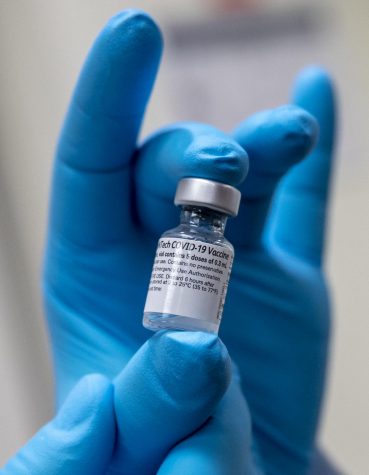
All 39 tribal nations in Oklahoma opted to receive the vaccine through the federal Indian Health Service (IHS), as opposed to receiving doses from the state of Oklahoma.
The Oklahoma City health service office reported, “Tribal nations have been a key part of our planning for the vaccine rollout so that American Indians and Alaska Natives will have equitable access to safe and effective COVID-19 vaccines. As of Feb. 12, the Oklahoma City Area Indian Health Service, which serves tribes in the state of Oklahoma, has distributed 209,225 COVID-19 vaccines to the tribal health programs.”
Buffy Heater, assistant deputy commissioner for the state health department, said the state’s Immunization Information System only collects state-allocated vaccine data, which includes American Indians who were vaccinated at county health departments and private healthcare providers and hospitals that administer the vaccine.
The Indian Health Service shares its vaccination data with the CDC rather than Oklahoma or any other state. With no direct communication, the state is unable to obtain those records easily. That’s why tribal vaccine numbers are not typically included in Oklahoma’s statewide reports, Reed said.
A few small tribal clinics do have a system that communicates with the state’s Immunization Information System, Reed said, “but that is maybe 5% of the total vaccines that are administered through that system. So at this point, that information is not communicated either by us, or by CDC when they reflect the numbers for the state.”
Oklahoma’s Department of Health is working with tribes, the CDC and the Indian Health Service to better understand what those numbers will look like for tribal nations in the state, Reed said.
Demand for the vaccine has been strong despite initial concerns that Oklahomans would shy away.
On Wednesday, Feb. 16, University of Oklahoma Health Services, along with IMMY Labs and the Cleveland County Health Department, announced a large-scale first-dose coronavirus vaccination clinic for Monday, Feb. 22.
The response was so swift that appointment slots for the 10,000 doses at the free clinic were filled up within 20 minutes. Bratzler said that is a promising sign that people are listening and signing up for immunizations.
“We’re in a bit of a race right now to get as much vaccine out there that we possibly can to slow the current spread, because if you slow spread you reduce the opportunities of mutation,” Bratzler said.
“When you get the opportunity to get the vaccine, unless you have a specific contraindication, please get the vaccine. It’s the best way to protect yourself. It is our pathway to getting back to the norm we used to remember.”
Gaylord News is a reporting project of the University of Oklahoma Gaylord College of Journalism and Mass Communication.

is a journalism major at the University of Oklahoma, with minors in Religious Studies and English, Literary and Cultural Studies. He was co-founder and editor of Rap Chronicle, an online music magazine that published between fall of 2014 of and spring of 2017. His other bylines can be found in NonDoc, The Norman Transcript, and OU Daily. Jessie has worked his way through college as a crew member/server at Norman restaurants. He reported in Washington D.C. during the 2020 presidential election on behalf of Gaylord News.

